“Even though the future seems far away, it is actually beginning right now.” -Mattie Stepanek
It's been a fantastic week here at Starts With A Bang, where we've covered even more ground than normal! First off, for those of you not following me on SoundCloud, we've got a new science podcast out, on the last star in the Universe.
- Will the 'Great Attractor' defeat dark energy? (for Ask Ethan),
- The stars of Andromeda, inside and out, as revealed by Hubble (for Mostly Mute Monday),
- Dimensional reduction: the key to physics' greatest mystery? (contributed by Sabine Hossenfelder),
- The physics of stopping a meteor with one punch,
- Could dark energy be caused by a reaction to what's in the Universe?, and
- What are the most energetic particles in the Universe?
And now lets take a look at your inquiries, ideas and more on this edition of our comments of the week!
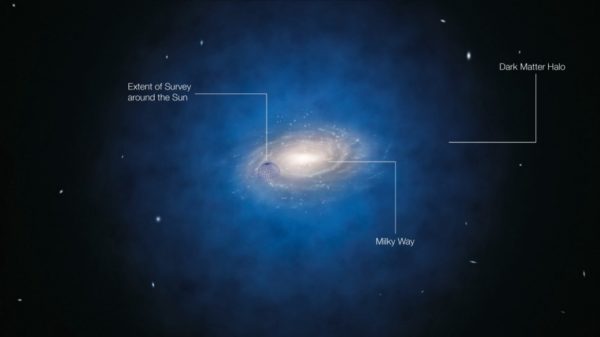 Image credit: ESO/L. Calçada, of the illustration of the dark matter halo surrounding the luminous disk of our galaxy.
Image credit: ESO/L. Calçada, of the illustration of the dark matter halo surrounding the luminous disk of our galaxy.
From Sinisa Lazarek on the MACHO content of our galaxy: "Maybe I’m nitpicking, but IMO “ten times more” is not “slightly more”. This of course doesn’t influence the DM halo AROUND the galaxy (where most of DM is). But I expected that 10x more machos would influence the mass content of our galaxy more than slightly."
It's not nitpicking; you're asking a questions about magnitudes. If you thought something was 2% and it turns out to be 20%, that's suddenly very significant. But if you thought something was 0.001% and it turns out to be 0.01%, then it doesn't matter. When we talk about the mass content of our galaxy, we are still much less than 1% when talking about MACHOs over the mass range we're discussing. So no, ten times more MACHOs still only influences the mass content of our galaxy slightly.
A modern high field clinical MRI scanner. MRI machines are the largest medical or scientific use of helium today. Image credit: Wikimedia Commons user KasugaHuang, under a c.c.a.-s.a.-3.0 license.
From eric on the consciousness problem: "Every night, the pattern of electrical activity that is the conscious “me” disappears. It doesn’t go underground somewhere in my brain or go into some standby/dormant mode, this pattern ceases to exist. Not there. Gone. Noneexistent. New patterns, associated with sleep and dreaming, take its place. Then when I wake up, my brain recreates the pattern that is “me” from stored information…probably not exactly the same as it was before, I just don’t notice the differences."
Now, this is a hard problem and I don't have an answer. But I would submit that MRI results would show that there is some brain (electrical) activity that is identifiably you that is still present while you are asleep. I would also submit that it is that electrical pattern that occurs in your brain that is identifiable as you. Here are some unanswered questions:
- Would that same electrical pattern existing elsewhere also be identifiable as you?
- Would you feel that same "youness" about it, waking up tomorrow as just electrical activity in another location, as you feel every day where you wake up?
- Is this continuity of our existence evidence of a real phenomenon, or is it an illusion?
- And if we created multiple copies of that electrical activity, would that continuity still exist?
 Tom and Will Riker, together on the Enterprise after the former's rescue. Image credit: Memory Alpha Wiki, by user ThomasHL, from the TNG episode Second Chances.
Tom and Will Riker, together on the Enterprise after the former's rescue. Image credit: Memory Alpha Wiki, by user ThomasHL, from the TNG episode Second Chances.
In other words, I don't know that, for example, Will and Tom Riker aren't both exactly 100% the same Will Riker that was born in Alaska? And yet, perhaps neither one actually is; perhaps the original "Will Riker" died the first time his body was deconstructed and reconstructed, with that line-of-consciousness coming to a total end. And perhaps all the memories and continuity experienced by the copy doesn't mean that it isn't murder every time one goes through the transporter. Is this different or the same than going to sleep and waking up?
I don't even know how to test this with a working transporter. Ideas?
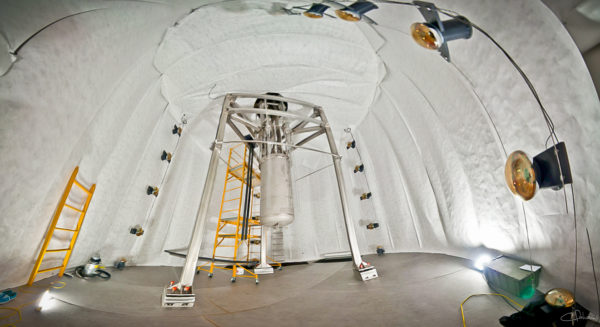 The LUX underground detector, installed and in the tank. Image credit: C.H. Faham and the LUX collaboration.
The LUX underground detector, installed and in the tank. Image credit: C.H. Faham and the LUX collaboration.
From Alan L. on dark matter and LUX: "So have DM particles yet managed to achieve a level of such extreme puniness that it would make DM, as envisaged post LUX, an extremely unlikely candidate to be one capable of pushing around Andromeda sized galaxies so to ensure a uniform rotational speeds across their width, as if DM particles in galactic haloes formed gangs of some kind of super powerful schoolyard bullies?"
You must understand that it is not the size, magnitude or puniness of dark matter that makes it viable or not as capable of accounting for the gravitational effect of the Universe. It is its density and its clustering properties, the latter of which are determined by its kinetic energy as a function of its mass. A class of dark matter that doesn't interact with normal matter or itself at all, that has only gravitational interactions with anything in this Universe, would be the ultimate nightmare scenario for experimental physicists, and yet it is a very real possibility for what the nature of dark matter could be.
It is up to us to push those limits in all mass ranges as far as we can go. We are constantly re-evaluating what the science tells us with a view to the full suite of evidence available, and as a result DM was replaced by CDM was replaced by Lambda-CDM, and now we are starting to find that the density profiles do not match simulations quite as well as we had hoped, which is leading to modified models of CDM as part of the Lambda-CDM model. Just because you may not like the path that science is being led doesn't mean that scientists aren't doing exactly the job that the data tells them to do.
 Composite image of the Bullet Group showing galaxies, hot gas (shown in pink) and dark matter (indicated in blue). Image credit: ESA / XMM-Newton / F. Gastaldello (INAF/IASF, Milano, Italy) / CFHTLS
Composite image of the Bullet Group showing galaxies, hot gas (shown in pink) and dark matter (indicated in blue). Image credit: ESA / XMM-Newton / F. Gastaldello (INAF/IASF, Milano, Italy) / CFHTLS
From Jerry on dark matter collisions: "Since two of the key pieces of evidence for dark matter is that galaxies rotate to fast to hold together and that dark matter can be mapped separating from galaxy clusters in collisions, what would happen to a galaxy that became completely separated from its dark matter halo after hitting an especially dense area of intergalactic matter?"
Intergalactic matter would only be able to stop the other intergalactic matter in a galaxy: things like plasma, dust, and neutral gas. You want to stop a star? You need something as dense and massive as a star. You want to stop a galaxy? You need to something that's going to stop not an "averaged galaxy," but each of the 100 billion+ stars in it. That's why, in the Bullet Group, above, the luminous stars move unimpeded through the group, while the gas (in pink) separates. If you truly wanted to allow the dark matter to continue moving while making your imaginary super-star-stopper stop the galaxy, you would forever alter the stars by nature of stopping the baryonic matter in the galaxies.
In other words, the answer isn't a universal physics one, but rather is dependent on how you do this thing that requires a severe, non-natural intervention.
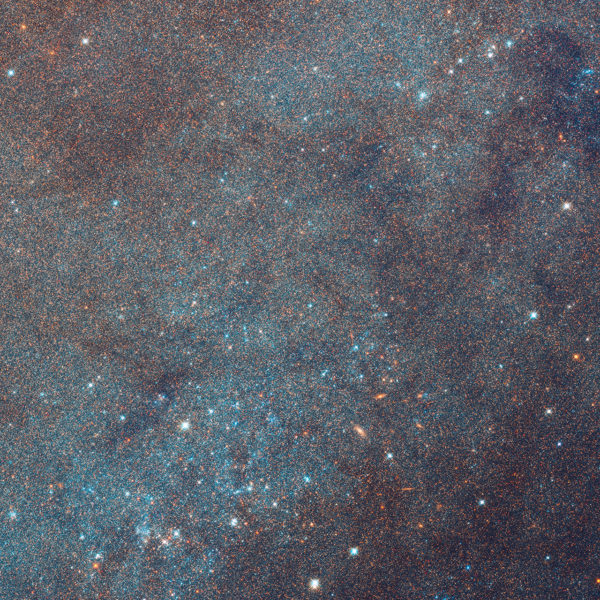 Closeup of a large region of the Andromeda galaxy's disk, containing hundreds of open star clusters (identifiable as bright blue sparkles). Image credit: NASA, ESA, J. Dalcanton, B.F. Williams, L.C. Johnson (University of Washington), the PHAT team, and R. Gendler.
Closeup of a large region of the Andromeda galaxy's disk, containing hundreds of open star clusters (identifiable as bright blue sparkles). Image credit: NASA, ESA, J. Dalcanton, B.F. Williams, L.C. Johnson (University of Washington), the PHAT team, and R. Gendler.
From PJ on the galaxies behind Andromeda: "Interesting to note the visibility of other galaxies through Andromeda in the closeup photo, lower right of photo, reddish appearance."
This is the less common type of galactic reddening we see: not due to redshift, but rather due to dust in a foreground galaxy! In fact, you will notice what appears to be a large population of red stars in this galaxy as well, and that's because the "dust" tends to exist in a thin plane in the galaxy's center. The stuff in front of the dust isn't reddened, but everything behind it -- including stars and galaxies -- experiences this extinction effect.
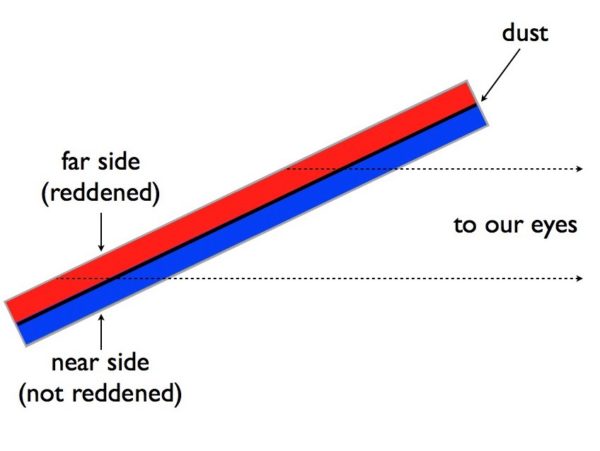 A crude model of a spiral galaxy, with equal numbers of stars throughout the entire volume of it. Image credit: E. Siegel.
A crude model of a spiral galaxy, with equal numbers of stars throughout the entire volume of it. Image credit: E. Siegel.
Dust grains are of a size where smaller wavelengths are blocked much more easily than longer ones, and so the more dust we pass through, the redder things appear. (Even though there's less red light, there's a higher percentage of red light as compared to everything else!) If you were to look at a region that wasn't dusty in Andromeda, the galaxies behind it would only appear red as a function of their redshift.
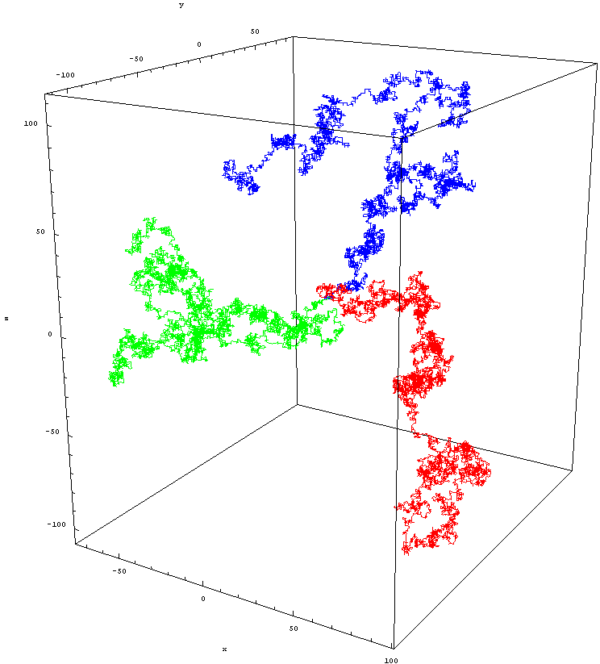 Isotropic random walk on the euclidean lattice Z^3. This picture shows three different walks after 10 000 unit steps, all three starting from the origin. Image credit: Zweistein, under c.c.a.-s.a.-3.0.
Isotropic random walk on the euclidean lattice Z^3. This picture shows three different walks after 10 000 unit steps, all three starting from the origin. Image credit: Zweistein, under c.c.a.-s.a.-3.0.
From Denier on the concept of dimensional reduction: "Would this mean it is possible to collapse 4 dimensions down to 2, or that the 4 dimensions that we perceive all around us are in fact 2 dimensions when viewed on the QM scale?"
It actually doesn't mean either of those. The former is definitely not what's being said, so drop that from your mind. The latter, though, is kind of close. Imagine you go to take a step in our three dimensional world. What direction will you go in? Realistically, you'll likely go some distance in the x direction, some in the y and some in the z direction. The odds that you'll come back to within a certain distance of your starting point on the second step are fairly low; you'd need to simultaneously get the exact opposite of each of those three directions that you took in your first step. If you were only two dimensional, you'd have better odds and in one dimension, even better odds.
What dimensional reduction says is that the "quantum mechanical fuzziness" of reality means that if you were to take the odds of returning to your starting point in four quantum dimensions, it's the same as in two classical dimensions, meaning that quantum mechanics increases significantly your odds of a random return. That's the big finding.
From See Noevo on superhero physics: "Do you have any articles in the works on Superman, or on each of the Marvel superheroes?"
I sure do. Go read it; you may enjoy it!
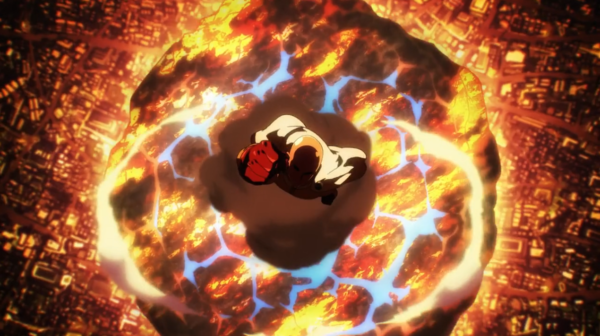 Saitama having just punched through the meteor, stopping its momentum and breaking it apart. From the Anime, "One Punch Man." Image credit: from Daisuki.net.
Saitama having just punched through the meteor, stopping its momentum and breaking it apart. From the Anime, "One Punch Man." Image credit: from Daisuki.net.
From Denier on the physics of One Punch Man: "“No sir” came the quick reply. “The damage is from the force of One Punch Man’s foot pushing against the Earth with enough force to instantly propel him to 99.99999997% the speed of light”."
The whole comment is accurate, and pretty spot on. As James Kakalios often says, you need to set out what the laws of physics are and how they are different or violated/not violated at the outset, and then you can construct comic book realities in a consistent fashion. One Punch Man's leap from the Moon back to Earth is more destructive to the Moon than his meteor-stopping punch is to Earth, even though the latter requires more energy. There must be something in that fist of his...
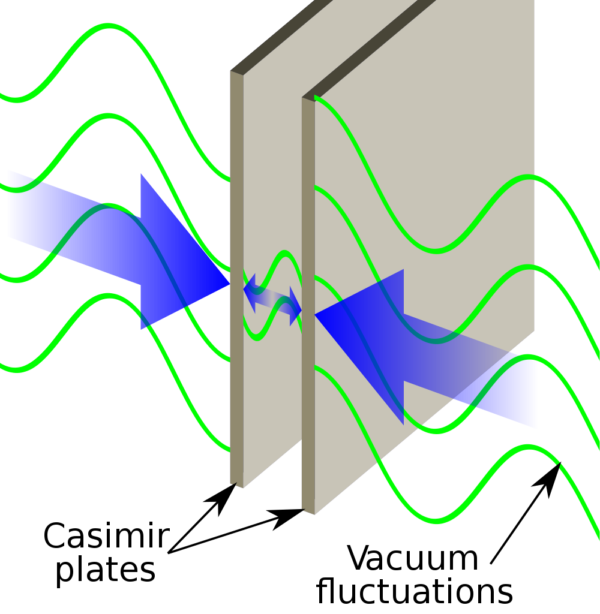 An illustration of the Casimir effect, and how the forces on the outside of the plates are different from the forces on the inside. Image credit: Wikimedia commons user Emok, under a c.c.a.-by-s.a.-3.0 license.
An illustration of the Casimir effect, and how the forces on the outside of the plates are different from the forces on the inside. Image credit: Wikimedia commons user Emok, under a c.c.a.-by-s.a.-3.0 license.
From Wow on a plausible dark energy explanation idea: "Imagine the [Casimir] plates half a universe apart. The energy density is lower inside, right? And as the plates get closer, the energy inside gets lower.
Now imagine that these plates are “unit metric” in the multidimensional universe of string theory.
Where all dimensions have the same metric, the energy is equally distributed in all dimensions. As the three dimensions expand, the higher dimensions “roll up”, and the “size” of the universal dimension shrinks and excludes more and more wavelengths, reducing the energy in those smaller dimensions.
However the energy goes SOMEWHERE, energy isn’t destroyed or created, it’s a constant total.
That energy goes into the remaining three dimensions."
As far as we can tell, the vacuum expectation value (we can call that energy) in the space inside the plates is different (lower) from the energy outside of the plates. As the plates get closer, more EM modes are forbidden, and hence the energy gets lower still. Your analogy is saying, rather than close down one dimension, forbidding modes (as in the space between the plates, you can still move arbitrarily in the other two), close down all the "extra" dimensions of string theory, thereby increasing the vacuum energy of our space.
All we need is a full theory of string theory where we can calculate the string vacuum from first principles, and the size of the dimensions that are compactified, and we can test this theory. Unfortunately, "string vacua" are undetermined from first principles, and this is one of the biggest frustrations of the whole string theory enterprise. It's a plausible idea, but not one that's in currently calculable territory today.
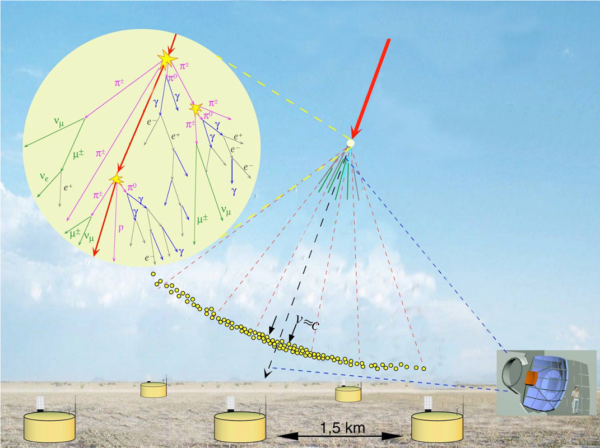 The production of a cosmic ray shower, produced by an incredibly energetic particle from far outside our Solar System. Image credit: Pierre Auger Observatory, via http://apcauger.in2p3.fr/Public/Presentation/.
The production of a cosmic ray shower, produced by an incredibly energetic particle from far outside our Solar System. Image credit: Pierre Auger Observatory, via http://apcauger.in2p3.fr/Public/Presentation/.
From eric on cosmic rays: "I find cloud chambers fascinating to watch. Any time I see one in a museum or science exhibit, I usually end up standing there much longer than planned. Evidently they’re relatively easy to build (there are loads of DIY videos and guides on the web), but I haven’t yet taken my minor obsession to that stage. "
And for that, here is a video of a cloud chamber with cosmic rays flying through it (timelapse):
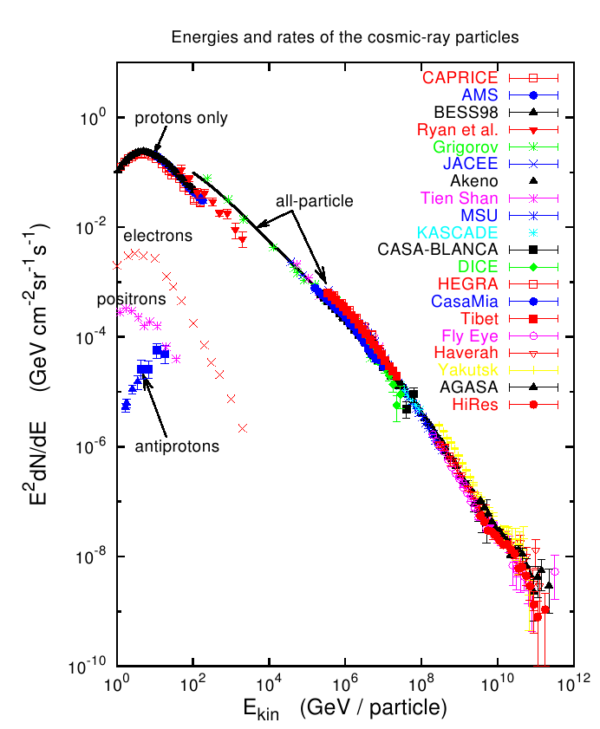 The spectrum of cosmic rays. Image credit: Hillas 2006, preprint arXiv:astro-ph/0607109 v2, via University of Hamburg.
The spectrum of cosmic rays. Image credit: Hillas 2006, preprint arXiv:astro-ph/0607109 v2, via University of Hamburg.
And finally, from Elle H.C. on cosmic rays and the LHC: "Objection: “The Large Hadron Collider (LHC) will collide in 2015 protons at √s ≃ 14 TeV. This impressive energy is still about a factor of 50 smaller than the centre-of-mass energy of the highest energy cosmic ray so far observed, assuming primary protons.”
While for the LHC the collision rate is even 1.000.000.000 higher then in nature. It’s like saying on elephant is more intense than all the +1 billion chinese people in the world."
This is an invalid objection based on a misunderstanding of the different between energy, collision energy and center-of-mass energy. Let's explain. A particle has a certain amount of kinetic energy relative to our reference frame: the energy of its motion. The highest energy we've ever created for a single particle (e.g., a proton, not counting particles made up of multiple protons) on Earth is ~6.5 TeV, which is an LHC proton. If you collide this proton with a fixed target, which is to say a proton at rest, you "only" get √(2mE) worth of energy for new particle creation, where m is the mass of the proton and E is the kinetic energy of the LHC proton. This is pretty lame for the LHC; we'd only get 114 GeV of energy, maximum, per collision for new particle creation. If you like, you can replace the LHC's energy with an ultra-high-energy-cosmic-ray's energy: 10^11 GeV, and find it reaches approximately 500 TeV of energy available for new creation. This is the center-of-mass energy referred to.
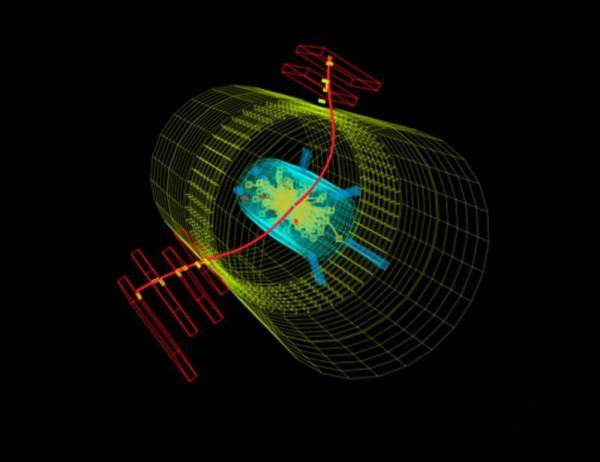 Image credit: CERN, via http://home.web.cern.ch/students-educators/updates/2013/04/find-higgs-b….
Image credit: CERN, via http://home.web.cern.ch/students-educators/updates/2013/04/find-higgs-b….
The way the LHC reaches 13 TeV for particle creation is by colliding 6.5 TeV protons with other 6.5 TeV protons moving with the opposite momentum. Assuming there are multiple UHECR sources in the Universe (there are), and that they shoot UHECRs at one another, it stands to reason that there are plenty of ultra-high-energy collisions, where "m" in that equation can be replaced by the energy of the other particle with an approximately equal-and-opposite energy. The Universe has had collisions that are ~10^7 times as powerful as what we make at the LHC. I'm not sure what your point is with the elephant analogy, but that's what the physics says and means. The energy of these cosmic rays is real and unique, and it's only that the center-of-mass collisions are both high energy and incredibly precisely localized that make the LHC interesting at all.
Thanks for a great week, and can't wait for another fantastic one starting tomorrow!


I've always found this Canadian short animation nicely illustrative of the philosophical and moral issues regarding the transporter: https://www.youtube.com/watch?v=pdxucpPq6Lc
But at the end of the day the scientific answers to transporter-related philosophy questions can only be had from experiment: but presuming that a post-transport individual is a sufficiently close replicate of the pre-transport individual then they cannot be expected to report a difference in their consciousness. On the other hand what objective experiment could be used to differentiate between the pre- and post- transport individuals?
If neuroscience someday gives a definitive answer to how consciousness arises from the brain's structures then that means that Will and Tom both have equal claim to the same identity. If neuroscience can give that answer then it can inform the answer to the transporter identity question in the positive, but never in the negative (unless the transportation process creates a measurable difference in Will and Tom's brains). If science can't give that answer then the solution to the identity question is unknowable.
Sure Ethan, give the alcoholic a drink. :) LOL.
Stephen King had an interesting little short story on idea of transportation (inspired by "The Stars My Destination" by Alfred Bester). The story was called "The Jaunt".
Hoping the link works:
https://drive.google.com/file/d/0B5Mew0gEo47xMVRwcF95TzFXZ3c/view
Well if the person is a volunteer then its probably legally some form of euthanasia. Or some legal status yet to be determined.
To be clear, I've been assuming the 'deconstruction' step is necessary for the technology to work when saying I would go through it voluntarily and not get angsty about it. But if a "copy, send, and reintegrate on return" technology is available (Chalker's Four Lords of the Diamond used this), I'd prefer that. If the being in the 'transmit' box doesn't have to die, why kill them? Just send a copy and get on with it. Legal questions such as property, inheritance, custody, etc. can be solved by some standard pre-existing agreement. This solution is particularly relevant if you assume we can't break c. If you're beaming me 500 LY away at c., I really don't care about the philosophical question of whether the person who arrives is really me, more me, or less me, or not. That copy will have his life, I will have mine, and there will generally be no troublesome legal overlaps.
The essence of the transportee is moved into a pattern buffer, which, in turn, is transmitted to the destination, then shifted out of the buffer. There is no deconstruction, or reconstruction resulting in the death of the original person, nor a copy of that person arriving at the target.
@ Ethan
Thanks so much for clarification on magnitudes and macho content. Much appreciated. What I was missing was that original estimate on macho contribution. I thought (wrongly) that they would contribute at least several % to galaxy's matter content.
@ Ethan:
You must understand that it is not the size, magnitude or puniness of dark matter that makes it viable or not as capable of accounting for the gravitational effect of the Universe. It is its density and its clustering properties, the latter of which are determined by its kinetic energy as a function of its mass.
I agree.
A class of dark matter that doesn’t interact with normal matter or itself at all, that has only gravitational interactions with anything in this Universe, would be the ultimate nightmare scenario for experimental physicists, and yet it is a very real possibility for what the nature of dark matter could be.
It needs must interact with normal matter, else galactic rotations would not be as they are.
Has anyone, anywhere, on planet Earth, ever, considered the possibility that DM particles, whatever they might be, could be the source of the universal gravitational force?
If so, what might be its mathematical sign?
"It needs must interact with normal matter, else galactic rotations would not be as they are."
Incorrect: it must warp the spacetime metric, either via the exchange of gravitons in the force of gravity, or via some interaction with the Higgs field (and/or similar scalar field).
No interaction between the two types are necessary, only that they are both affected by gravity.
"All we need is a full theory of string theory where we can calculate the string vacuum from first principles, and the size of the dimensions that are compactified, and we can test this theory. Unfortunately, “string vacua” are undetermined from first principles"
Aye, the paper I remember reading didn't have much mathematics in it, and could well have been one of the "Letters" that propose very early hypotheses that aren't possible to write an actual scientific paper on.
What I DID like about it was that it ought to proffer some differences to physics in the very early universe and would indicate that dark energy will decrease in the future faster than we could otherwise expect.
IOW it would give a different universe IF (and this would be a really BIG "if") it were so.
The concept is simple enough for even laymen and the lazy (like me) to get and play with (as long as we're honest about the playtime) and is WHY I find physics so damn interesting in and of itself.
"There is no deconstruction, or reconstruction resulting in the death of the original person,"
Except in the encoding of that someone into the buffer. Those aren't my atoms any more. They're the "message". It may also contain the mass-energy of my corporeal state so that they don't have a massive explosion at the transmission site and a huge electric bill at the receiving station, but my atoms can't be there, never mind in the order that is physically "me",
"If so, what might be its mathematical sign?"
2, a gauge boson. It has to be spin-2 because it should appear the same helical pattern whether coming or going, which occurs only on a spin-2 gauge boson.
We call it "The Graviton", and it's not dark matter.
re my post #9, reconsidering, whether DE increases or decreases depends on the rates of coiling of the dimensions and the rate of energy density increase necessary to keep expanding.
I'm pretty sure ONE of my books has, though not the paper, a comment by someone on it in a popularisation of string theory and/or big bang cosmology.
That's still getting on for a hundred books, few of which are particularly easy reads, and, as eric pointed out, may have been munged with other expectations and be harder to spot on a careless read.
I might have a holiday back in Birmingham and visit the Uni I went to, see if walking round the library triggers anything.
I DO know it's not my idea, though, it's poached, definitely.
Alright so if the individual energy of the LHC-protons is ~6.5 Tev, then this gives us a factor of 100 smaller than the most extreme UHECR-protons instead of 50 mentioned in the paper.
The elephant analogy is about distribution, where do you draw the line between an individual and a group? A better example is perhaps a hammer vs. a drill, the strike of a hammer may be more massive, but a drill with a high rpm can be an even more energetic tool. The same goes for UHECR-protons which are a heavy blast, but the LHC has a density and frequency (rounds per seconds) that is a billion times higher, and whom are only a factor of 100 lighter. So the vibration rate of the LHC is actually far more intenser than UHECR's.
Dropping one light grain of flower (50 micro grams) vs. a heavy corn grain (0.05 g) vs. a 5kg bag of flower grains.
What's vibrating?. Beam energy and intensity do not combine to equal a vibration. You're just throwing around terms without understanding them. Or, more likely, you got the idea of universal 'vibrations' from some woo source and think it must have some relevance here.
A different question for you, Elle: the LHC has been in operation since September 2008, almost 8 years now. So why exactly hasn't your doom and gloom scenario occurred yet? Your contention that banging together these particles is will lead to the destruction of all matter or stranglets or whatever seems to be undermined by the fact that we've been banging them together for 8 years now.
@Eric
"What’s vibrating?"
The particles that make up Dirac's sea, maybe dark matter, maybe the Higgsfield, gravitons … what is it that fills up SpaceTime? Wouldn't it vibrate, as in time for things to take place.
Did you know that the LHC is continuously becomming more and more intense with record luminosity, maybe at some point a threshold will be surpassed. I'm not saying anything will happen, my main objection is that UHECR's aren't a solid reference when you also consider frequency and density of the collisions.
Btw these proposed vibrations have got nothing to do with some hollistic view, just making the comparison to how heat vibrations can ignite a fire, or how Wow talks about space contracting or expanding (waves).
BTW if you look at the stars you see a lot of 'doom and gloom' it is not like it is all peace and quit out there, if you look at what mankind can do, than why not consider a supernovae ignited by an intelligent life form like ours that can already build H-bombs for more than 60 years.
https://en.m.wikipedia.org/wiki/Ivy_Mike
One shouldn't be too naive either, these aren't just toys, these are deep explorations passing boundaries.
No, it twirls and does the foxtrot. If that sounds like something so incredibly silly that you can dismiss it out of hand, keep in mind the evidence for what you said and the evidence for what I said is exactly the same.
If you're hypothesizing some resonance at a certain energy (which is how I read your other posts), luminosity is irrelevant; it doesn't change the collision or particle energy. But I think your ideas are so mixed up you don't really know what you're suggesting.
@Eric,
The vibrations are a normal extrapolations that an event affects its wider surroundings, and twirls aren't that far fetched as we can can get eddies.
I am hypothizing a resonance caused by every collision, just like how the small flowergrain pushes the air around when falling down, creating small resonances and eddies in the air, now have a billion of them fall at once ... that is luminosity the amount of collisions per second.
The issue here is that you put a long and intense stress on matter surrounding the collision spot at the lhc, just like how anything tires out if you keep on putting it under heavy stress be it in this case caused by the resonance. Similar to how you can lit a fire by using a loupe and concentrating unharmfull light. It is at the focus point that matter starts to burn.
I certainly would not rule out the Charleston a priori.
No, that logic doesn't work either way: vibration isn't required to 'affect its wider surroundings' nor does affecting ones' wider surroundings require vibration. As far as I can tell, you've taken a word referring to a specific type of physical movement and decided to use it to hide intellectual vagueness.
Well then, this is easy: we observe these collisions and observe no resonance. Since you're claiming they occur in every such collision, your hypothesis is inconsistent with a whole lot of (8 years' worth of beam runs at the LHC, 85 years' worth of beam runs counting other accelerators) evidence. Its time to discard it and move on.
Moreover, when asked why the reaction you hypothesize hasn't and doesn't occur in nature, you claim its because the LHC is reaching peak energies not found in nature. But your seeds-in-air analogy seems to claim that intensity is the key factor, because many particles can combine together to create your hypothesized effect. Well, nature certainly gives us high-intensity beams and reactions. So why doesn't it happen there? And don't say its because natural beams don't reach the energy needed energy - you just spent your entire last message explaining via analogy how, in your hypothesis, a large amount of lower-energy particles will collectively cause this effect to occur.
@Eric
I'm not sure that you do realize that light is a wave and a particle, and that a wave is a vibration; I'm also not sure if you got the news that there are gravity waves; even neutrinos are waves, actually what does not wave??
My point was that the energies haven't been strong enough to shake matter apart, just like colliders were not strong enough to create a Higgs boson. Just like how it takes some time for a loupe to generate a fire. With resonance it takes some time, to heat up, things do not happen instantaneously.
Question how could we notice if Quarks shake slightly harder or slower, without disruption the mechanism of the proton? We can only study the functioning of a proton by blasting it apart.
You say: "Well, nature certainly gives us high-intensity beams and reactions"
Ha, sure, astrophysical jets being spewed out of accretion disks of quasars and Black Holes, those are indeed top references for a save peaceful place, I guess not. :)
Re teleportation for those who may not have read it;
https://en.wikipedia.org/wiki/Transporter_(Star_Trek)
:)
@C.H.elle #21: Your projection of ignorance onto others astounds me.
"How could we notice if Quarks [sic] shake [sic] slightly harder or slower?" By observing excited states, which are well known and well understood. For example, one well-known excited state of the proton is the Delta+. Another is the N(1440)+.
"We can only study the functioning of a proton by blasting it apart." False, and a deponstration of your ignorance. Intermediate energy elastic scattering of electrons on protons (and neutrons), as well as deep inelastic scattering, directly probe the quark and gluon content, spin distribution, and form factors of the proton and neutron _without_ "blasting them apart."
@Michael,
That's interesting, thanks. I'm curious if they (can) do these tests next to where the LHC is colliding protons, or if maybe the collisions cause too much noise to do this kind of observation?
BTW Ethan just wrote in his latest article:
"If you want to study the internal structure of a proton or collection of nuclei, deep inelastic scattering is the only way to go."
Photons have a frequency. That's quite different from the statement that everything in the universe has a vibration. This is one problem with using analogies; its easy to take them too far.
But you said resonances occur in every reaction. Is that true, or do you only think they occur in reactions of a certain energy? And what is that energy?
Your idea seems a lot like a "god of the gaps" idea - as we do more experiments, you are always moving the prediction of what energy/intensity will cause it to the next thing we haven't tried. Before we turned on the LHC, folk like you thought the initial beam would do it. When it didn't, you decided a higher energy beam would do it. When that didn't, you upped the energy again. Every time we smash stuff together at a higher energy or intensity (or both) and your dire prediction doesn't come true, you simply shift the prediction to the next planned experiment. Its clear, in this case, you have no credible or thought-out physical hypothesis underlying your predictions, because if you did, that hypothesis could be used to calculate a specific energy and then when a reaction at that energy failed to yield the predicted result, you would give it up. But this is more like God of the Gaps; wherever science hasn't yet gone, that's where your prediction lies.
Which is a good double-entendre to end on.
@Eric,
"electromagnetic radiation consists of electromagnetic waves"
Look, I am not predicting anything, I am simply pointing at something that should be considered.
Heating things up is one of the most straightforward concepts in nature, so I would expect it to be considered in the safety report. Regarding energizing matter, UHECRs are not a solid reference, as their frequency and density is extremely low, just a short flash vs. the LHC that fires for a long time at one specific spot with ever increasing luminosity.
BTW Isn't it the most idiotic thing to bring up 'God of the gaps' when wanting to defend something like the LHC, when the whole point is to keep on going until they find something new. ;)
Well then I have good news!
It was considered. There you go; a published report by CERN considering your problem. Now you can stop asking LHC scientists to consider it, because they did.
Of course, you and I know that in reality, you aren't satisfied with this consideration, are you? Its pretty clear from your constantly bringing this up that, in reality, you'll only be satisfied if or when the outcome of our consideration agrees with your preferred outcome.
@Eric,
The issue of high frequency collisions for a longer period, gradually heating up matter, is not discussed in the report. They only have looked at single events.
"And on my deathbed I'll get all the answers / even if all my questions are taken away"
"No, that logic doesn’t work either way: vibration isn’t required to ‘affect its wider surroundings’ nor does affecting ones’ wider surroundings require vibration. "
And the claim "affect its wider surroundings" is itself illogical from the get go,
the moron chelle doesn't understand "piss off", so what the hell's the chance of the moron understanding logic, never mind what "vibration" is and isn't.
Chelle's only point now is to show how vacant the woomancer ideology is.
@Wow,
"… via some interaction with the Higgs field (and/or similar scalar field)."
So you may suggest the above, but if I bring up vibrations, one the most natural things, …
That's because Einstein's publication on the photoelectric effect is considered a much more accurate model of how beam intensity relates to possible reactions than Elle's blog-comment publication on the 'many flowergrains in air' model. of how intensity relates to possible reactions Where they disagree, physicists tend to go with Einstein.
Vibrations of what, caused by what, leading to what, studied in what experiment and with the results published in what journal, that would be relevant to the LHC? Yes clearly, some things vibrate, just as some things interact with the Higgs field. But that doesn't mean everything vibrates, just like not everything interacts with the Higgs field (photons don't). And it doesn't mean we have a credible reason to believe that some unknown vibrational state will cause the destruction of all matter, any more than evidence for the Higgs field should lead us to believe that when the number of people reach 8 billion their interaction with the Higgs field will cause a heretofore unknown reaction that causes the destruction of all matter. If someone claimed the latter, we'd demand some quantitative theoretical physics calculation to back it up. And when the population topped that number and nothing happened, we'd call it a failure. The same goes for your idea.
@Eric,
FYI
The photoelectric effect is one of the key stones of Wave–particle duality, which is the concept that every elementary particle or quanticentity may be partly described in terms not only of particles, but also of waves. It expresses the inability of the classical concepts "particle" or "wave" to fully describe the behavior of quantum-scale objects. As Einstein wrote: "It seems as though we must use sometimes the one theory and sometimes the other, while at times we may use either. We are faced with a new kind of difficulty. We have two contradictory pictures of reality; separately neither of them fully explains the phenomena of light, but together they do".
https://en.wikipedia.org/wiki/Wave%E2%80%93particle_duality
Right, you have to use QM wavefunctions to most accurately describe how photons particles like protons interact with other stuff. And when you actually use QM to do that, you end up with the photoelectric effect, not the 'many flower grains in air' effect. And maybe Mike can correct me, but I'm pretty sure QMical calculations of interactions also refutes your claim that every reaction has a resonance.
@Eric,
The 'many flower grains' is mainly about timing, think of an hourglass which gives the grains the time to settle, vs. letting them drop all at once. The same question could be asked at the LHC; the higher the luminosity gets, is there still enough time for matter to relax again, or are things heated up under stress of some resonance?
BTW I am as curious as you are to know if each reaction produces resonance.
"but if I bring up vibrations, one the most natural things, …"
Nope, "vibrations" are nonexistent in nature. Find me a vibration on its own, you fucking idiot.
"Vibrations of what, caused by what, leading to what, "
Remember, eric, idiot fucking woomancer morons like chelle don't "do" "what". They make claims based off a wordsalad selection they don't understand and cannot explain.
Explain to those who are at least theoretically capable of understanding reality where idiots like chelle are going wrong.
Wow,
I'm sure that Eric can make up his own mind and opinions without your help.
Regarding 'vibrations in nature' this might help you :p
http://www.elle.com/beauty/news/g15887/the-best-vibrators-for-every-sit…?